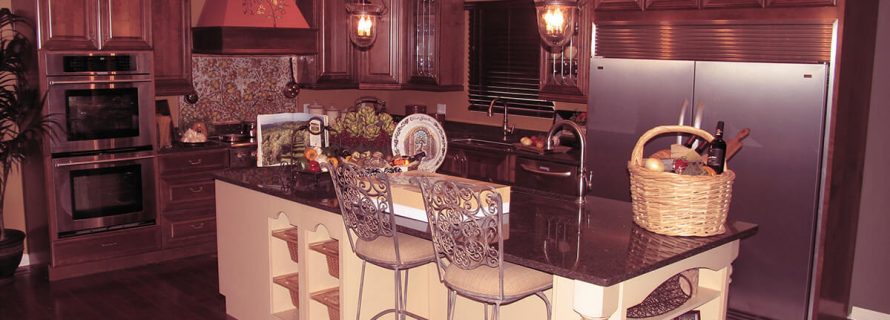4 essentials of a rustic kitchen

While clean lines and shiny appliances are characteristic of a modern kitchen renovation, sometimes people prefer a more aged look and feel for their dining area – especially for a kitchen within an older home. Many homeowners with Colonial or Spanish-style houses request a warm, inviting kitchen that welcomes in guests and flows nicely with the other rooms in their home. Rustic kitchens are popular, and with the right attention to detail, can become one of the most beautiful indoor spaces. Alure Home Improvements' kitchen and bathroom designer Roman Gorelin explained exactly how to achieve this look for your kitchen.
"Fake beams can easily be installed for the look without the structural support."
1. Exposed beams
When you first imagine a rustic kitchen, you may picture a cabin-like space with high ceilings and lots of wood everywhere. One way to achieve this look is with exposed beams, explained Gorelin. If your home naturally has beams, this ties in perfectly with the aged look of your dining space. You may just want to add a stain to enhance them and have them match the colors of your kitchen. Contractors can also install them in homes without naturally exposed structures.
"Fake beams can easily be installed for the look without the structural support," said Gorelin.
2. Aged materials
Wooden cabinets, flooring and countertops are all characteristic of this type of kitchen renovation. Cherry, walnut and other hard woods are popular finishes, as they're rich and warm. However, even more important than the color is the wood's quality, explained Gorelin. Knotty and reclaimed or hand-scraped wood that's porous and imperfect is ideal for achieving a rustic look. Not only is this a great choice for cabinetry, but it also makes for the perfect countertop. Try installing a butcher block top for an especially raw, aged look for your new kitchen.
Aside from wood, there are many other materials that work well with the rustic style. Marinace granite countertops, which feature large rock designs, instantly create a rich atmosphere that ties in well with this look and feel. Additionally, travertine is another fitting material for flooring, as it's a naturally porous stone that's gray or tan in color. Similarly, terracotta, a red-orange concrete characteristic of Spanish-style homes, is another option to consider when designing a rustic kitchen.
3. Architectural details
Another way to achieve this look is with the appropriate architectural details. With the right accents, you can enjoy a new kitchen that looks tastefully aged. Included in your kitchen remodel should be turned posts, placed on either side of appliances, to maintain a rustic vibe and keep modern styles at bay.
"You might want to place chunky paneling on both sides of the stove area to take away from the modern look of stainless steel appliances," suggested Gorelin.
The sink should also be a major focal point in a rustic kitchen. A large, white porcelain farm-style sink is a great choice, as it hangs over the front of the kitchen cabinets and draws in your eye. Copper sinks also fit in line with the rustic theme. Try beaten copper for an aged look that ties everything together perfectly.

4. Cohesive design
A rustic kitchen is a bold design statement. As such, it may look out of place if the rest of the home isn't similarly designed.
"This look can work in a variety of homes depending on decor and other details," said Gorelin. "But usually, it works best in older houses, like Spanish-style, Colonial and capes."
For a more cohesive look, keep a similar look throughout the home. Stay away from modern influences, and decorate the other rooms in the home with rich paint and accents.
- Additions and New Construction
- All Exteriors
- Alterations
- Basements
- Bathrooms
- Customer Service
- Customer Stories
- Decks
- Design & Planning Show
- DIY
- Doors
- Educational Resources
- Extreme Makeover Home Edition
- Fashion Show
- General Remodeling
- Green Living
- Handyman Home Services
- Home Decor
- Home Entertainment
- Home Improvement
- Home Improvements
- How to Tips
- In The Community
- Kitchens
- Off-the-Wall Remodeling Stories
- Remodeling
- Resources
- Roofing
- Siding
- Social Media
- Sunrooms
- Tips & Tricks
- Trends
- Windows

